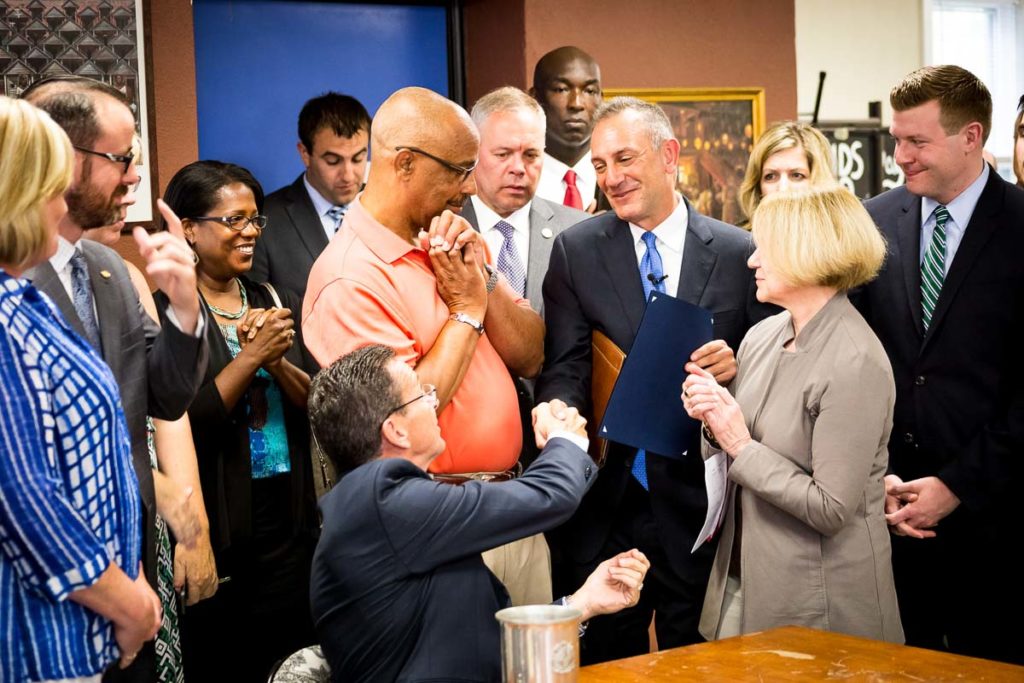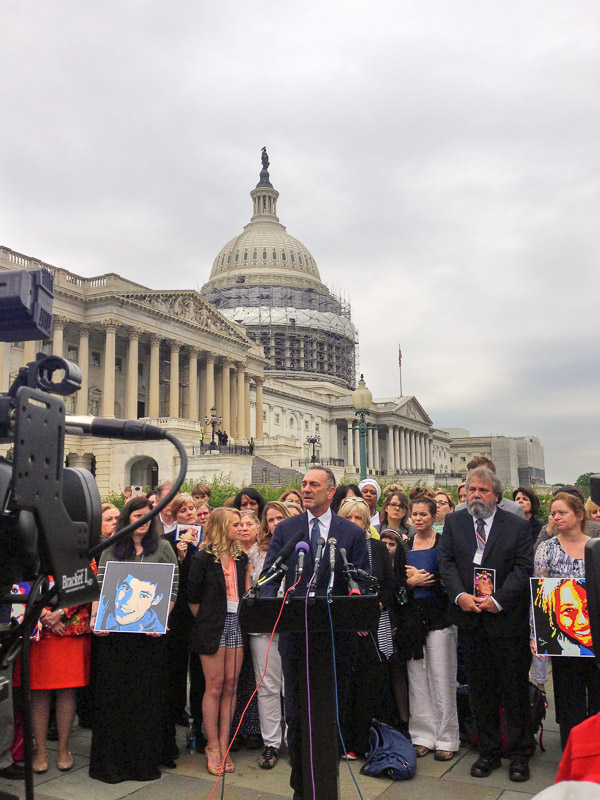Looking addiction straight in the eye—and treating it with science and empathy

(Photo credit: Jesse Winter)
Listening to hotel executive Gary Mendell ’79 talk about his son Brian, and Brian’s decade-long struggle with addiction, you might get misty-eyed yourself. Brian, who stayed up all night with a suicidal woman to give her hope. Who, encountering another woman alone and depressed on her first day of treatment, walked up to her, gave her a hug, and whispered, “It’s going to be okay.” Who, despite having little money of his own, handed out five-dollar bills outside a restaurant to all the homeless people he could find. “After he died, I got calls from people who knew him while he was in treatment, and they were crying hysterically, saying they should have died instead of my son—that if it weren’t for Brian, they wouldn’t be alive,” Mendell said. “There was story after story about how he had helped others.”
Now, through Shatterproof, the national organization that Mendell founded to change how addiction is perceived, prevented, and treated, Brian is continuing to help others years after his death in 2011 at the age of 25.
Every parent’s child
Mendell, cofounder and chairman of HEI Hotels and Resorts, tried to “fathom going on” without his son. Since Brian had done well in treatment programs but quickly relapsed in halfway houses and sober homes, Mendell considered buying a house in Connecticut and opening “a really good halfway house” to help 10 or 20 teens a year transition from treatment to ordinary life. But before those plans could take shape, he was prodded by his business background to think bigger. “At the Hotel School and throughout a career in business, you’re always thinking about scaling—taking things and duplicating them around the country and doing something larger,” he said. “It’s what you’re taught. It becomes part of your DNA.”

To better understand the field of addiction, Mendell spent three months meeting with researchers in prevention, treatment, and recovery. He learned the vast reach of the disease: that more than 20 million Americans were addicted to drugs or alcohol (today that figure is more than 22 million); that addiction affected one in five families (now one in four); that addiction was the third-leading cause of death (drug overdoses are now the leading cause of death for adults under age 50). He learned that 80 percent of addicts become addicted before their 18th birthdays. “As a society, we are not protecting our teens, who are too young to protect themselves,” he said. “The area of the brain relating to caution and logic does not fully develop until their early 20s, making it more likely that they will take risks.”
Mendell learned that evidence-based prevention and treatment programs already existed that could have helped Brian and the 370 other Americans who, each day, lose their lives to addiction. But, despite having been published in peer-reviewed medical journals, “most of it was hardly being used,” he said. “I asked myself, how can this be? How can we have something that is so big, that relates to our children, where we have information today that can start saving lives tomorrow, and we’re not using it?”
He learned that the stigma attached to the disease prevented those afflicted from getting help. “It wasn’t just addiction that took Brian’s life,” he said. “It was the feeling of shame he had every morning when he opened his eyes—it was the feeling of being an outcast. Because of that stigma, families don’t want to deal with addiction, doctors don’t want to treat it, research is woefully low compared to that for other diseases.”
As he thought about all he had learned, Mendell realized that, while every other major disease had a well-funded national organization, addiction did not. “At that moment, I looked up at a photo of Brian helping someone on the street, the last photo of him ever taken, and I felt him giving me a message to go help other people, to create an organization and a movement that would motivate our society to look this disease straight in the eye, prevent it, and treat it—with programs based on science, and with love and empathy, just as we do for other diseases.”
At its inception, in 2012, the organization was called Brian’s Wish. (Brian’s wish, Mendell said, had been that “someday, people will understand that I’m not a bad person—I’m a good person who’s trying his hardest.”) As the vision grew from a small, local charity to a large national one, Mendell decided to rebrand the nonprofit to reflect that “this was no longer about my child; it was about every parent’s child.” Shatterproof, he said, “speaks to shatterproofing our children so that they don’t become addicted to drugs or alcohol. For those who are already addicted, it’s about putting a protective coat on them with evidence-based treatment and no shame or stigma. The icing on the cake is the word ‘proof’—not my opinion, not your opinion, but what the research shows.”
Shatterproof now has 35 employees and has raised more than $30 million. Its website, shatterproof.org, is the premier online resource for families affected by substance-use disorders.
Action, advocacy, and support
Shatterproof’s multiple initiatives all share a common goal: to improve outcomes and save lives.
Last year, Mendell formed the Substance Use Disorder (SUD) Treatment Task Force, a public-private group of top addiction experts, to ensure that every American with an SUD has access to treatment based upon proven research. (Currently, just one in 10 receives any form of treatment, and much of that treatment is delivered without the use of evidence-based practice.)
The task force’s first deliverable, the National Principles of Care, creates a universal standard for the treatment of addiction. This standard is derived from the Surgeon General’s Report on Alcohol, Drugs, and Health, which is backed by three decades of research and endorsed by all five federal agencies most responsible for addiction policy. The document identifies eight essential criteria for treatment: routine screenings; personalized treatment plans for each patient; rapid access to treatment; disease management, achieved through long-term outpatient care; coordinated care for each physical and mental illness; behavioral healthcare delivered by trained and accredited providers; medication-assisted treatment; and access to nonmedical recovery support services. The Principles have been adopted by 16 healthcare payers, including five of the six largest health insurers in the country—United Health Group, Anthem, Aetna, Cigna, and Centene Corporation. All together, the 16 insurers provide coverage to over 248 million people.

Shatterproof’s Workplace Initiative was also launched last year, in partnership with the National Safety Council and the National Opinion Research Center at the University of Chicago. “The Real Cost of Substance Use to Employers,” a tool developed by Shatterproof, allows business leaders to calculate the costs of substance use to their workplace based on size of employee base, industry, and state. This May, several companies began piloting the initiative’s education module, which identifies strategies to reduce the costs, stigma, and impacts of addiction while building work environments that are recovery-friendly. (Seventy-five percent of adults with SUD are in the workforce, accounting for annual costs estimated at $442 billion.)
On the advocacy front, Shatterproof has championed legislation in 14 states that is already saving some thousand lives a year. The organization was a lead advocate for the Centers for Disease Control and Prevention’s Guideline for Prescribing Opioids for Chronic Pain, a set of 12 recommendations for ensuring patient access to safer, more effective chronic pain management while reducing the numbers who misuse or overdose from opioids. Its report, “Prescription Drug Monitoring Programs: Critical Elements of Effective State Legislation,” has been widely adopted and has led to changed legislation in numerous states.

Through the Shatterproof Ambassador Program, more than 1,100 ambassadors work to create change by testifying at state and federal legislative hearings, being interviewed by the media, attending community events, writing op-eds, and sharing their personal stories about addiction. Ambassadors testified in support of the Comprehensive Addiction and Recovery Act, signed into law by President Obama in 2016, which authorized $181 million in spending for treatment, prevention, and recovery programs. The act also allows nurse practitioners and physician’s assistants to prescribe buprenorphine, a safer, less addictive, and less euphoria-inducing opioid medication that can block the effects of other opioids. The drug is used to help patients stay in treatment by suppressing symptoms of opioid withdrawal and reducing cravings for stronger drugs.
Additionally, Shatterproof created the 5K walk/run Rise Up Against Addiction, the largest-ever event series for addiction, which this year will be hosted in 11 communities across the country. “We bring families together to support each other, end the stigma of addiction, and raise valuable funding for our cause,” Mendell said, noting that his background in hospitality “helps bring these events to life so that they connect with people emotionally.”
Later this year, the organization will launch another initiative: Shatterproof Family Support Groups, offering families a peer-to-peer support forum for evidence-based education, the sharing of experiences, and social connection.
The hospitality connection
Addiction is a cause that hits home for the hospitality industry, where, studies show, the disease strikes at twice the rate seen in other industries. Mendell said he owes a debt of gratitude to the hospitality community, “which has been extremely generous in helping to launch Shatterproof and build our programs, donating over $2 million over the last several years.”
Through sponsorship of the inaugural Shatterproof Hospitality Heroes Reception, held this past January at the Americas Lodging Investment Summit (ALIS), 40 hospitality companies contributed more than $580,000 toward Shatterproof’s mission. In 2016 and 2017, Shatterproof raised over $1.6 million by hosting, alongside ALIS, the Shatterproof Challenge Rappel, in which participants either rappelled down 26 stories of the JW Marriott Los Angeles L.A. LIVE or supported colleagues who did so.

Several Hotelies are involved with Shatterproof, sponsoring events and helping to recruit other sponsors, hosting corporate rappel teams, and serving on committees. They include Joel Eisemann, MPS ’80, chief development officer for the Americas at InterContinental Hotels Group (IHG); Dan Lesser ’79, president and chief executive officer at LW Hospitality Advisors; Art Adler ’78, chairman of the Americas division of Jones Lang LaSalle’s Hotels and Hospitality Group; Mark Woodworth ’77, MPS ’78, senior managing director of CBRE Hotels’ Americas Research; and Jordan Mendell ’07, a vice president at Wells Fargo Bank and Mendell’s nephew.
Before launching Shatterproof, Mendell, who earned an MBA with distinction from the Wharton School, spent more than 25 years in the hotel industry. In 1985, he cofounded HEI Hotels and Resorts with his brother, Steve ’82. “At the time, I was 26 and he was 25, and we started it in my basement,” he said, admitting, “It sounds kind of crazy.” HEI became one of the fastest-growing hotel investment firms in the country; in 1997, Mendell sold a majority of the company to Starwood Lodging Trust, which named him president and elected him to its board of trustees. He resigned from Starwood in 1998 to pursue entrepreneurial activities, ultimately reestablishing HEI in 2002. Now a multi-billion-dollar company, HEI manages 75 hotels, encompassing brands from Starwood, Marriott, Hilton, Pullman, IHG, and Hyatt along with six independents and food and beverage operations for restaurants at the W Hollywood and W Chicago.
Mendell sees many parallels between his hospitality and nonprofit careers. “I run Shatterproof like a business, with measurable goals,” he said. “And I run our events with cost controls comparable to what we used in the hotel industry.” Both endeavors, he said, are decentralized and empower people “to do what’s best for their local market, with guidelines from the national organization or corporate office. At Shatterproof, our emphasis is on leadership, systems, and measurable results. It’s run like a business that does advocacy work and delivers measurable programs that save lives. That’s not how nonprofits are generally perceived.”
Due to its rapid growth, Shatterproof has not yet developed a formal internship program, but it does have interns at its New York City office and “would love to have interns from the Hotel School,” he said. He credits the Hotel School with instilling in him “a way of thinking that has helped me grow my hotel business and also grow Shatterproof to be able to save as many lives as possible, as quickly as possible.” A proud alum, Mendell received the Hospitality Innovator Award from the Pillsbury Institute for Hospitality Entrepreneurship in 2007. One year earlier, he and his brother gave a joint presentation in the Dean’s Distinguished Lecture Series.

A matter of chemistry, not character
Having traveled a road that is every parent’s worst nightmare, Mendell is determined to save others from a similar experience. “The last several years have been the most difficult of my life,” he said, “but my heart is warmed every day by the generosity of so many people. I’ve met wonderful people from all over the country, people who have lost children and people who have no connection to the disease but simply want to help. In many respects, I feel blessed to be able to serve and help others.”
Looking ahead, Mendell said the key to solving the crisis lies in changing the way people view addiction. “What I failed to understand as a parent—and I wish I could take back time—is that Brian’s brain chemistry had changed. Addiction is a disease. It’s about chemistry, not character. If we can understand that as a society and show empathy—just like we do when someone has diabetes—more people will seek treatment, fewer people will die, and fewer families will be shattered beyond repair.”
“There’s no question that Shatterproof will save hundreds of thousands of lives—we’re already saving thousands,” he said. “Over the next several years, as we fundamentally change and improve the treatment system in the United States, we’ll be helping 15-to-20 million people a year. There’s no ‘if’—we’re going to do that.”
—Written by Sandi Mulconry, a freelance writer for the Cornell SC Johnson College of Business


5 Comments
Barbara A. Hitch
Thank you for all your efforts. The world needs more people like you. My father died at age 57 of the effect of alcoholism that he struggled with for as long as I can remember. At his funeral, several people came up to me telling that my father( and his story) literally saved their lives. Like your son Brian , he wanted and could help others , but lost his own struggle.
Patty Shaub
Hi Mr. MENDELL, I AM SO SORRY FOR THE LOSS OF UOUR SON, Brian..I am dealing with a grandson who is an addict for almost 20 years.. like you I know it has affected his brain chemistry. But his dad doesn’t understand that, an thinks he can just choice not to use. He ignores his crys for help, in just spending time together. Adam will never truly recover till he ments his relationship with his dad. I don’t know how to reach his dad to get him involved in Adam’s. Recovery???? Please help me in helping Adam. Thank you for all you do.Patty
Gary Mendell
Hello Barbara, thank you for your comment. I am so sorry to hear of the loss of your father. He sounds like a remarkable man who, like Brian, understood that addiction doesn’t make you a bad person. It makes you a sick person, who needs medical care, just like with any other disease. I hope you’ll consider joining our Shatterproof community. Visit shatterproof.org and click “subscribe” at the top right.
Gary Mendell
Hi Patty, I’m so glad you reached out. This is such a tough thing for so many parents. It can be hard to understand why your loved one can’t just “choose” to stop hurting himself and his loved ones. But you’re right, it all comes down to brain chemistry. I would encourage you to visit shatterproof.org and check out our resources. There are many articles, cited with scientific evidence, about how addiction works, how it hijacks the brain, and how it is most effectively treated. Perhaps you can share those resources with your son. Best of luck to you—your grandson will be in my thoughts.
Joy Ream
Hi Gary,
will look to Shatterproof.org, etc for the many articles with scientific evidence…if you can point me to any research specific to opioid addiction AND ADHD treatment, I’d be very grateful. thank you. thank you for all you’re doing to reduce the stigma and increase the sharing of science /evidence based treatment….
Comments are closed.